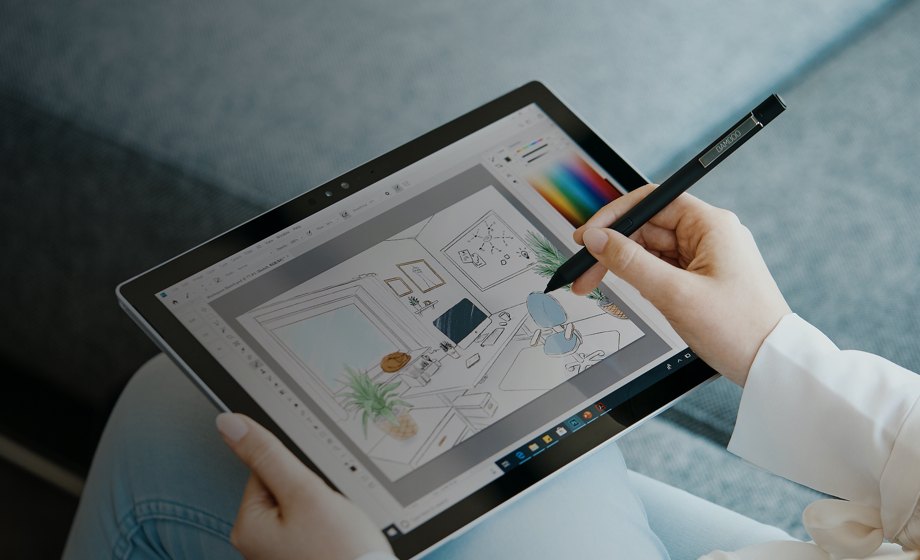Stifttabletts
Mit einem präzisen Stift kannst du auf einem reaktionsschnellen Pad skizzieren, zeichnen und Bilder bearbeiten und deine Werke auf einem Bildschirm begutachten.


Wenn du diese grundlegenden Prinzipien der Fotobearbeitung berücksichtigst, kannst du dich ganz beruhigt an die Bearbeitung deiner Fotos machen. Egal, ob es darum geht, zu lernen, wie man Fotos richtig zuschneidet, oder zu entscheiden, wie und wann Fotos retuschiert werden sollten – halte dich an diese Regeln und deine Bilder sehen schärfer und detailreicher aus und behalten ihre Qualität.

Du solltest unbedingt eine Kopie des Bildes machen, an dem du arbeitest, zum einen zur Sicherung und zum anderen, damit du darauf zurückgreifen und wieder ganz neu anfangen kannst, falls dir deine Bearbeitungen nicht gefallen oder du einen ganz anderen Ansatz ausprobieren möchtest. Ebenso wichtig ist es, bei der Durchführung von Änderungen in einer Fotobearbeitungssoftware Ebenen zu verwenden, damit das zugrunde liegende Originalbild unverändert bleibt. Auf diese Weise steht dir immer eine schnelle und einfache Referenz zur Verfügung, um zu schauen, wie das Original aussah, bevor du damit begonnen hast, Farben zu optimieren, bestimmte Bereiche zu retuschieren und mit dem Kontrast zu experimentieren.
Das Zuschneiden gehört zu den grundlegendsten Werkzeugen einer Fotobearbeitungssoftware, aber auch zu denen mit der größten Wirkung. Wenn du dieses richtig beherrschst, kannst du die Teile eines Bildes entfernen, die wenig Aussagekraft besitzen, um so stärker die hervorzuheben, die für die Bildaussage wichtig sind. Das kann bedeuten, großflächige Hintergründe aus einem Porträt- oder Tierfoto zu entfernen oder bestimmte Größen und Seitenverhältnisse zu verwenden, damit eine Aufnahme perfekt aussieht. Ein Verhältnis von 6:5 eignet sich gut für ein Bild mit einer Breite von 600 Pixeln. Quadratische Zuschnitte sind eine eindrucksvolle Alternative.

So einfach das klingen mag, so wichtig ist es, die Größenverhältnisse beizubehalten, wenn du die Größe eines Bildes änderst. Das bedeutet, dass das Verhältnis von Breite zu Höhe gleich bleiben muss, um die Perspektive beizubehalten und zu verhindern, dass ein Bild verzerrt oder gestreckt wird. Wenn du Bilder um mehr als 100 Prozent vergrößerst, werden sie pixelig. Allerdings ist es durch Neuberechnung möglich, die Größe eines Bildes ohne Qualitätsverluste zu ändern. Bei der Neuberechnung wird die Anzahl der Pixel in einem Bild geändert. Du kannst in einer Fotobearbeitungssoftware auch die Auflösung und damit die Qualität des resultierenden Bildes ändern – so haben Bilder für das Internet meist eine niedrigere Auflösung als Bilder für den Printbereich.

Das Retuschieren von Haut und anderen Aspekten eines Bildes gehört zu den Tätigkeiten in der Fotobearbeitung, die am meisten Spaß machen. Wer grundlegende Bearbeitungswerkzeuge wie die zur Bereichsreparatur oder zum Kopieren bzw. Klonen beherrscht, kann Bilder schnell bereinigen, um sie schöner aussehen zu lassen. Diese Funktionen sollten jedoch sparsam eingesetzt werden. Der übertriebene Einsatz von Retuschetechniken in Porträts lässt Motive schnell unrealistisch erscheinen, während übermäßiges Klonen dazu führt, dass Landschaften fremdartig und künstlich wirken, insbesondere, wenn du eigentlich ein natürliches Aussehen beibehalten möchtest. Diese Regel gilt auch für Farbe und Sättigung. Wenn du hier übertreibst, kann die Bildbearbeitung übertrieben wirken, und du musst zum Original zurückkehren und von vorn beginnen.
Alle Wacom Stifttabletts verfügen über Drucksensitivität und bieten so eine bessere Kontrolle über Strichbreite, Deckkraft und Strichintensität.
Das Erzielen des perfekten Kontrasts in einem Bild sollte in jedem Bildbearbeitungsprogramm oberste Priorität haben. Bei Verwendung der grundlegenden Bildbearbeitungswerkzeuge zur Optimierung eines Fotos kann es jedoch passieren, dass die dunklen Bereiche zu dunkel und die hellen Bereiche ausgewaschen aussehen. Deshalb solltest du dich stattdessen mit der Verwendung von Tonwertkorrekturen und Gradationskurven in deiner Fotobearbeitungssoftware vertraut machen. Damit kannst du den Kontrast eines Bildes wesentlich besser einstellen, da du bestimmte Bereiche korrigieren und Schatten und Mitteltöne nach Belieben festlegen kannst. Wenn du dich mit diesen Funktionen vertraut machst, wird das schnell dazu führen, dass deine Bilder vom Bildschirm quasi ins Auge "springen".

Wenn du deine Fotobearbeitungsfähigkeiten perfektionieren willst, solltest du auch lernen, wie du deinen Monitor für die Bildbearbeitung kalibrierst. Du kannst dies über deinen Computer tun oder aber über spezielle Hardware, die deinen Bildschirm prüft, um sicherzustellen, dass die auf deinem Display gezeigten Farben perfekt sind. Das bedeutet, dass beim Drucken von Bildern keine Probleme auftreten und du nicht feststellen musst, dass die gedruckten nicht mit den angezeigten Farben übereinstimmen.
Das Wacom Intuos Pro ist der perfekte Begleiter für eine bessere Fotobearbeitung. Das schlanke Tablett wird mit dem höchst sensitiven Wacom Pro Pen 2 geliefert, mit dem du auch feinste Details in deinen Bildern optimieren kannst. Das Wacom Intuos Pro aus hochwertigen Materialien wurde streng nach professionellen Standards getestet und ist eindeutig ein Schritt in Richtung hervorragender Fotobearbeitung.
Empfohlenes Produkt

Wacom Intuos Pro
Mit einem präzisen Stift kannst du auf einem reaktionsschnellen Pad skizzieren, zeichnen und Bilder bearbeiten und deine Werke auf einem Bildschirm begutachten.

Mit einem präzisen Stift kannst du auf einem reaktionsschnellen Pad skizzieren, zeichnen und Bilder bearbeiten und deine Werke auf einem Bildschirm begutachten.

Zeichne, entwerfe und kreiere direkt mit einem präzisen Stift auf einem hochauflösenden Bildschirm.

Schreibe mit einem Stift auf Papier und verwandle deine handschriftlichen in digitale Notizen.

Mit einem Wacom Eingabestift kannst du auf deinem mobilen Gerät schreiben und handschriftlich Notizen machen.
Wacom verfolgt die Vision, Menschen und Technologie durch natürliche Schnittstellentechnologien enger zusammenzubringen. Diese Vision hat das Unternehmen zum weltweit führenden Hersteller interaktiver Stifttabletts und -Displays sowie digitaler Eingabestifte und Lösungen für die Speicherung und Verarbeitung digitaler Signaturen gemacht. Die fortschrittliche Technologie der intuitiven Eingabegeräte von Wacom wurde bei einigen der aufregendsten Werke in den Bereichen Digital Art, Film, Spezialeffekte, Mode und Design weltweit eingesetzt und bietet Geschäfts- und Privatanwendern als führende Schnittstellentechnologie die Möglichkeit, ihre Persönlichkeit zum Ausdruck zu bringen. Wacom wurde 1983 gegründet und ist ein globales Unternehmen mit Sitz in Japan (Tokyo Stock Exchange 6727) mit weltweiten Tochtergesellschaften und Niederlassungen zur Bereitstellung von Marketing und Vertrieb in über 150 Ländern.